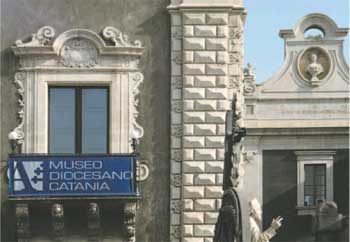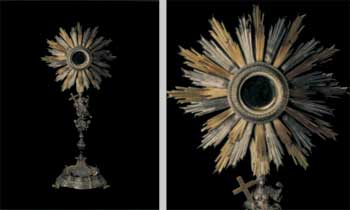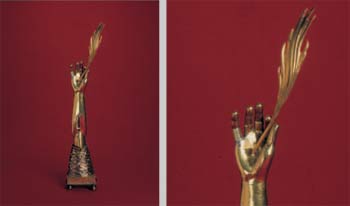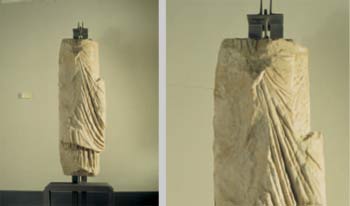
MUSEO DIOCESANO DI CATANIA
Via Etnea 8
tel. 095/281635
![]() critical
text by
critical
text by
Lucilla
Brancato
In
Elisabetta Censabella, the 'loss of the aura' caused to the cultural goods
in the modern era by commodification lead to the de-sacralization of the
monstrance, which she turned into an industrial design mirror, to link
sacred furniture to the profane one, industrial serial production to the
uniqueness of handicraft.
Massimo di Rocco plays with the Braccio reliquiario di San Sebastiano
(Reliquary arm of St Sebastian) in a sort of transposition. Inside a 'domestic'
bathtub-urn, a luminous plexiglass shrine, turned clockwise, reveals the
'relic' of a playful St Sebastian pierced by suction pad arrows.
The use of everyday objects recurs also in the photographical rereading
by Milena Nicosia of the Frammento di figura femminile (Fragment of a
female figure). Her digital prints re-contextualize materials with a strong
womanly connotation, bringing about an intimate recognition on the body
beyond its immediate corporeity.
Ambra
Stazzone
Notwithstanding
the evident difficulty of having to reckon, in the creation of their works,
with a collection such as the one in the Museo Diocesano di Catania, which,
though varied and interesting, gathers works that are extremely far from
the contemporary artistic attitude, the artists chosen for the second
edition of this project - Censabella, Di Rocco and Nicosia - succeeded
in reaching the aim of the project itself. Their works, in fact, are directed
not only to a comparison with the ones belonging to the collection, but,
above all, through the use of an intimist-ironic language, to establish
a direct relationship with the viewer.





